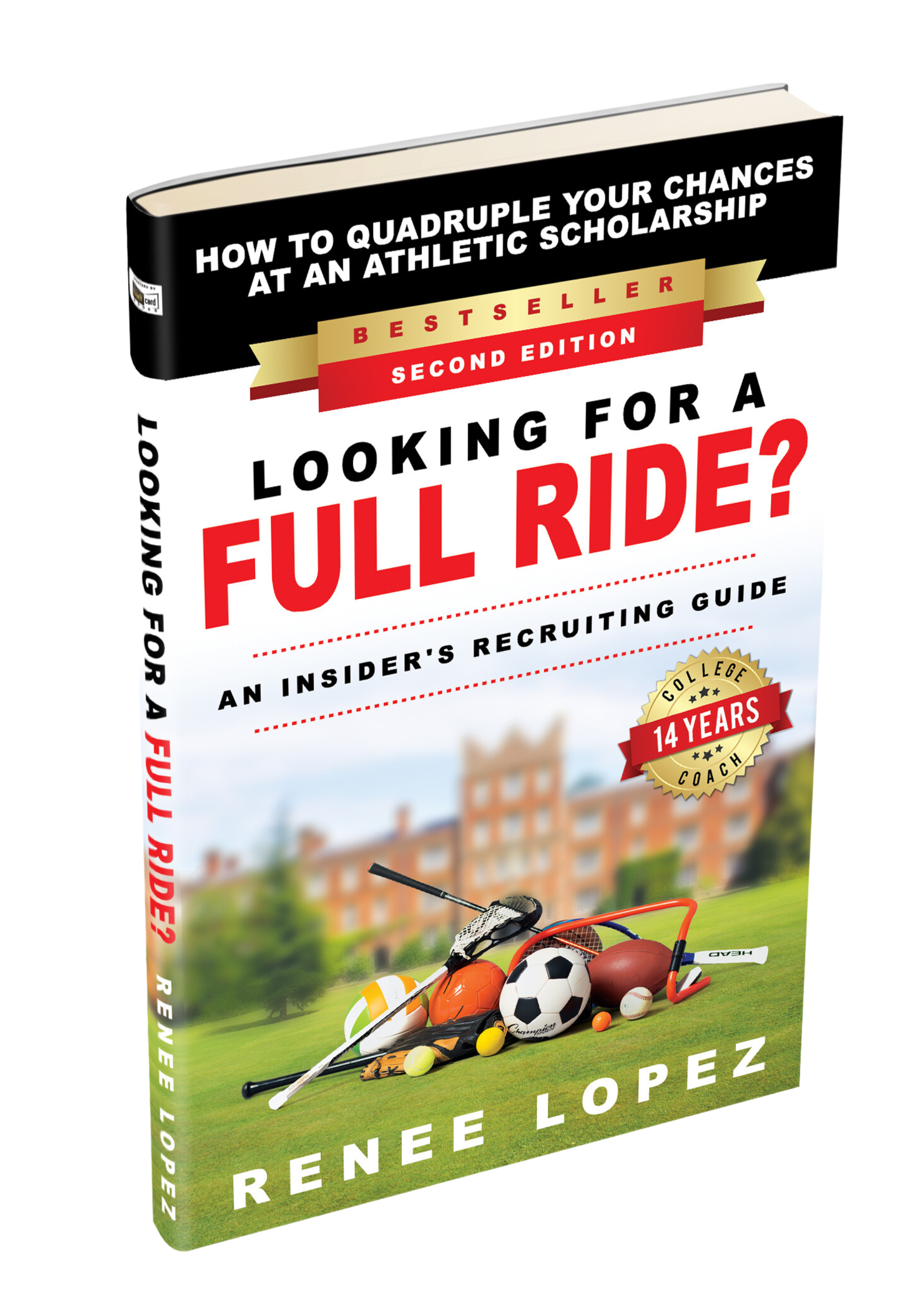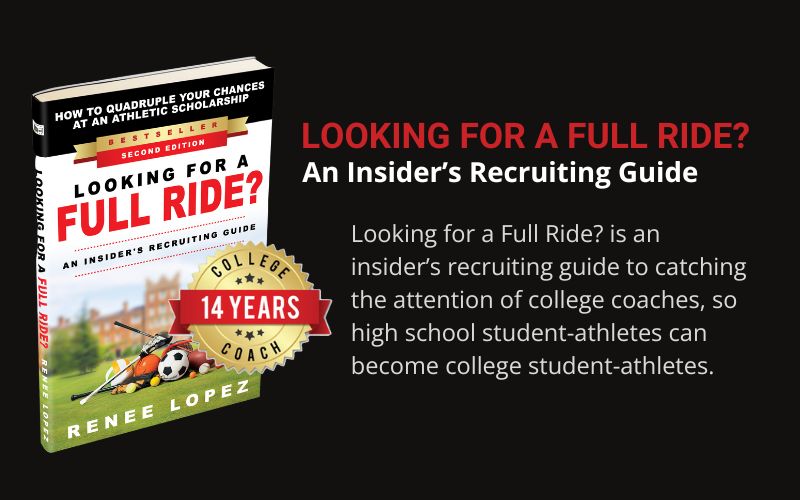9 Most Frequently Asked Financial Aid Questions
As many student-athletes apply to college, they often look for an athletic scholarship to cover the financial stress. Depending on the specific sport, only about 5-8% high school athletes go on to play college sports and even fewer receive athletic scholarships. In consulting with families on the college recruiting process, one of the most frequently asked questions is ‘What do we do when we get the academic and athletic scholarships and we still have $1000s to pay to attend their favorite college?’.
While each college awards grants, loans, and other scholarships in their own way, it is important for you to understand the financial aid process. You will need to inquire about the specific procedures for the college you are applying to. However, there are some common procedures that we wanted to address for student-athletes and their families.
This week, I have decided to bring in an expert as a guest blogger, Nannette Kamien, to address the most frequently asked questions on the financial aid. Nannette is an experienced financial planner and Principal of Inspiration Financial Planning. Her business specializes in helping families plan financially for college.
I have asked her to help to break down the process into simple steps to help you understand the entire process:
1. Which financial aid forms should I fill out?
All schools require the FAFSA (Free Application for Federal Student Aid) in order to be considered for federal student aid – grants, loans, and federal work-study. As its name implies, the FAFSA is free to fill out. Most schools also use the FAFSA results in order to award their own financial aid in the form of merit scholarships, grants, or institutional work-study.
Some schools require the CSS Profile in addition to the FAFSA in order to calculate their own financial aid using a different formula. You can find this list here. This form is not free to fill out, as each school requires an additional fee.
You may also find that a few schools require a third form specific to the institution to supplement the information provided on the FAFSA and/or CSS. The school’s financial aid website will usually let you know if this is required.
2. Should we bother to apply if we don’t think we’ll qualify?
I recommend everyone fill out the FAFSA. Many people who think they won’t qualify, actually do. And some schools may require students to complete the FAFSA for merit scholarships. If a family cannot write a check for the full cost of attendance at every school their child is applying to, then they should apply for financial aid, that’s the litmus test I use. There is nothing to lose but the time you spend filling out the forms. Although it takes time, it’s better than forfeiting available financial aid by not applying.
3. Does the FAFSA calculate how much financial aid you will receive from a school?
No, the FAFSA calculates an Expected Family Contribution (EFC) – which is a number the government calculates that your family should be able to contribute to pay for college each year for that student. Each school you apply to then calculates your “financial need” for that school (the Cost of Attendance – EFC = Financial Need) and then creates a financial aid award based on that.
Some schools cover 100% of need, most don’t. It is almost always the case that your EFC is higher than you think it should be, and the amount of financial aid offered is lower than you think it should be. See my blog post for more about What the EFC Tells You, and What it Doesn’t.
4. What if parents are divorced or separated? Which parent’s financial information will be used?
The parent with whom the child resided most during the 12 months prior to completing the aid application is called the “Custodial Parent”—that’s the parent who completes the FAFSA. It’s important to remember that the custodial parent may not necessarily be the parent who was awarded custody in the divorce settlement, nor is it always the parent who claims the dependent on their taxes. It is all based on who the student lives with, as well as a stepparent if the custodial parent is remarried.
The FAFSA has no questions about non-custodial parents, but the CSS PROFILE form does. Almost all schools that use the PROFILE require an additional non-custodial parent profile which asks financial questions about the other parent (and stepparent) the student is not living with. I recently wrote a blog post to help parents understand the rules regarding who may be classified as parents for financial aid purposes.
5. Can my student declare independence from her parents while she’s in college, and therefore, get more financial aid?
If the college decides that a student is no longer a dependent of his parents, then the college won’t assess the parents’ income and assets at all. But it’s the federal government and the colleges themselves who get to decide who is dependent and who is independent, and it is obviously in their best interest to decide that the student is still dependent. Don’t get your hopes up. Most kids who are considered independent are foster kids, or kids who have been legally declared independent from their parents.
6. Does the FAFSA look at home equity?
The FAFSA does not count equity (home value – amount owed) for your primary home in the EFC calculation. It does consider equity in other properties as a parental asset.
The CSS Profile does ask about primary home equity in addition to equity in other properties. Each school then decides how they will count it toward the EFC. Some schools assess the full value of the equity as a parental asset. Some schools use a multiple of parental income as the amount counted as a parental asset. You can ask how a school assesses this asset, but it may change from year to year, and schools may not even tell you.
7. Does the FAFSA look at retirement accounts?
Money in qualified retirement plans, such as a 401(k), 403(b), IRA, pension, SEP, SIMPLE, Keogh and certain annuities, is not reported as an asset on the FAFSA. If you are saving for retirement in a taxable investment account, it WILL be counted as an asset on the FAFSA.
8. I heard there is a way to hide assets and income for financial aid purposes. Is that possible?
There may be some financial strategies that can be used to work within the financial aid rules, to improve a family’s financial aid position. However, some strategies that are sold as a way to do this, actually harm the family’s overall financial picture and may not be worth pursuing.
Financial Aid Officers at the schools are savvy at spotting inconsistent information in the financial aid applications and may ask for verification of the numbers submitted. It’s best to be honest in submitting your application. Work with an experienced financial professional who will help you maximize all of the strategies your family may be eligible for, and that fit with your long term financial goals, without trying to sell you a solution that’s shortsighted. If it sounds too good to be true, it usually is!
9. What’s the best way to find scholarships?
Many families have the impression there is a lot of money available from outside or private scholarships. There are some little-known awards from private companies, foundations, community organizations, churches and other benefactors. There is money to be had from those sources, and they may be worth applying for, but you won’t likely get a free ride from outside scholarships alone.
The best way to get scholarships is to apply to colleges that may provide options. Financial aid offices earmark a certain percentage of money every year just to lure academically appealing students. This practice is called preferential packaging, and it’s not a dirty secret. The better the fit between you and a college, the more likely that school will entice you to attend.
If you wish to learn more about college financial planning from Nannette Kamien, you can contact her at Inspiration Financial Planning. Mention this blog post for a $50 discount on her college planning package.
college@inspirationplanning.com
Would you like help with the college recruiting process?
1. Go to www.lookingforafullride.com to get your FREE Report: Strategies to Emailing A College Coach.
2. Want some help with the recruiting process? Join some of our 9 Facebook Groups:
- Parents of High School Student Athletes Walking Through The Process (All Sports)
- Beyond Xs & Os 4 HS Athletes: Health, Recruiting, Team Building, Mental Training (All Sports)
- Athletic Recruiting Education for Principals, AD's, and Counselors (All Sports)
- Club/HS Coaches Learning College Recruiting Process (All Sports)
- Play College Soccer (Soccer Specifically)
- College Recruiting for GK's (Soccer Specifically)
- Mindset & Leadership Lessons for Athletes, Coaches/Teachers, & Business Leaders (All Sports & Business Leaders)
- Positive Team Building for Pro, College, HS & Youth Coaches (All Sports)
- Christian Competitors (Coaches & Athletes Serving Christ @Field/Court/Gym) (Sports Ministry for All)
3. Would you like her to do individual consulting with your family to get an insider’s perspective?
Email info@lookingforafullride.com for more details.
4. Did you know Coach Renee Lopez can come to your school or sports organization?
Email info@lookingforafullride.com for more details.
Coach Renee Lopez

As a 17 year coaching veteran, Renee Lopez is a recruiting expert for high school student athletes. She uses her NCAA Division I, II, and NAIA Head Coaching experience to help families navigate the recruiting process to be identified by college coaches and help them find the right “fit” for playing at the next level.
She presents recruiting seminars across the country, has recently been featured on ESPN Radio, and is the author of the book, “Looking For A FULL RIDE?: An Insider’s Recruiting Guide” where she interviewed 65 college recruiters across all sports and college levels.
She also does private consulting for student-athletes and their families to help in understanding the often daunting process of recruiting. (See one family’s testimonial.) If you are looking for help in the college recruiting process, please email Coach Renee Lopez at info@lookingforafullride.com.



